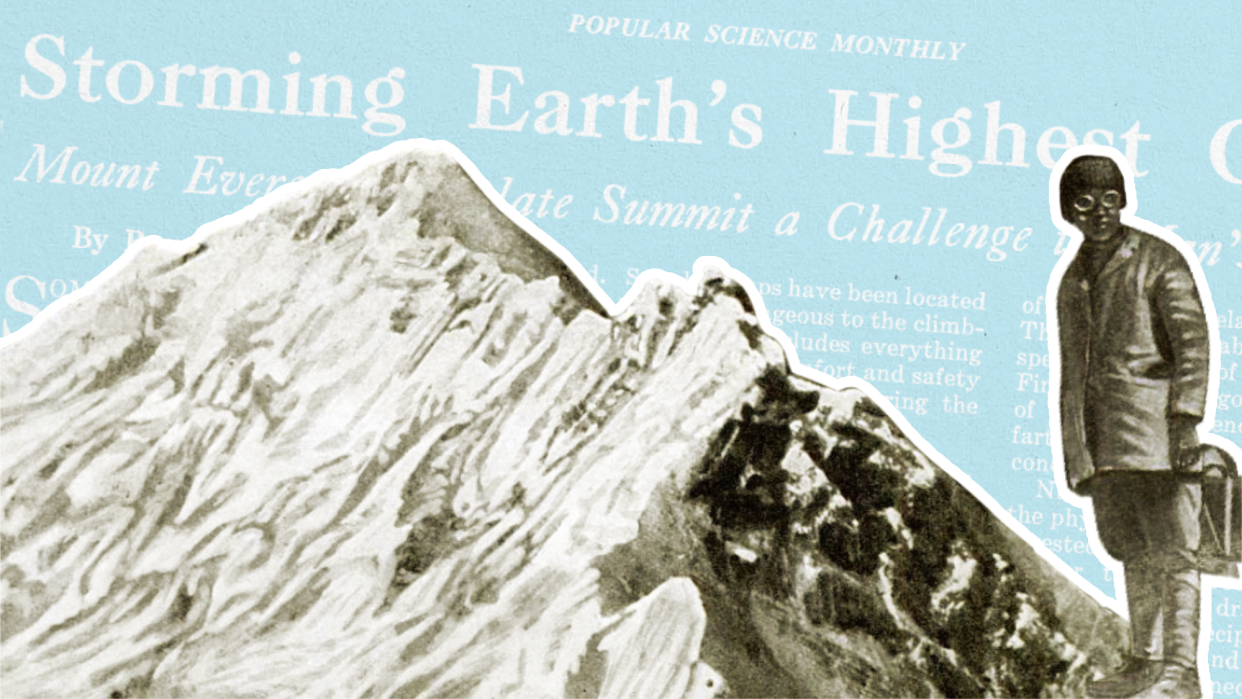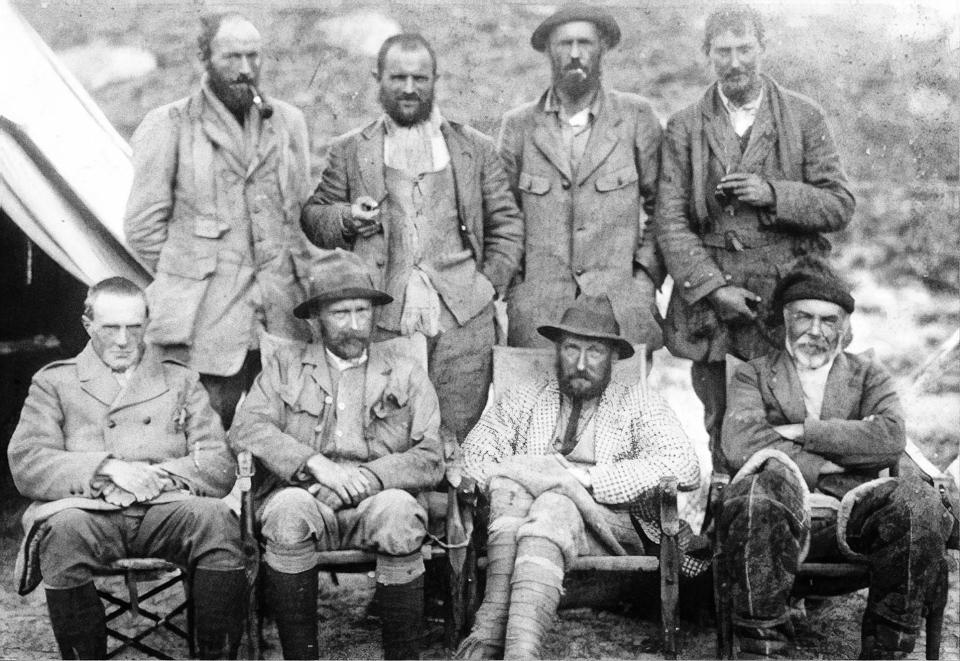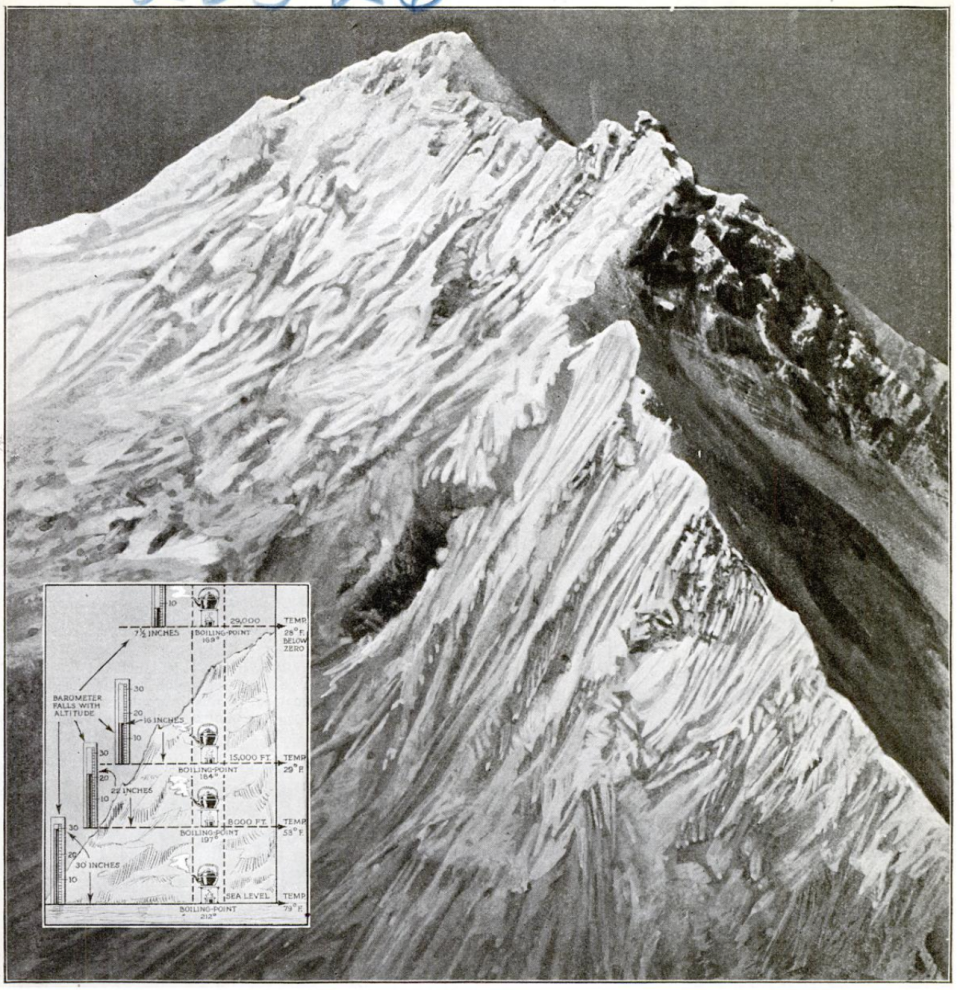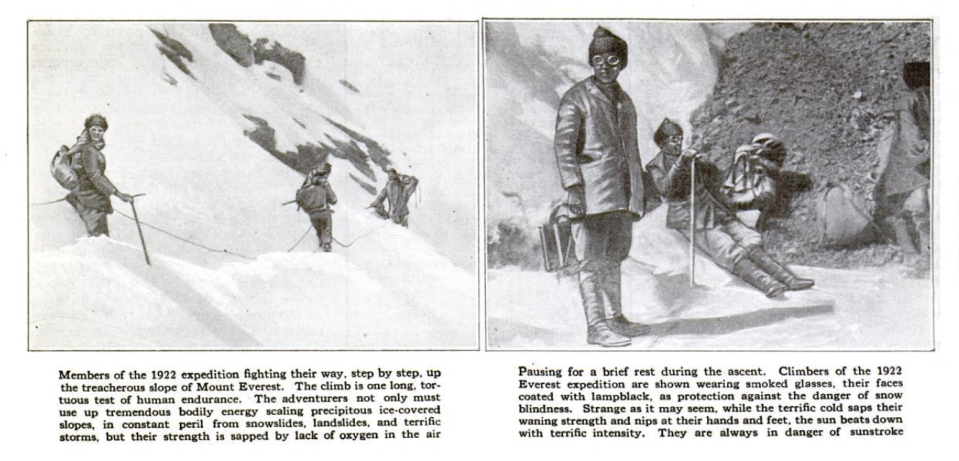May 1924: Popular Science profiles George Mallory's tragic quest to conquer Everest

- Oops!Something went wrong.Please try again later.
A century ago, in May 1924, Popular Science covered one of the earliest attempts to scale Mount Everest. When the story hit magazine stands in 1924, the outcome of the much-anticipated expedition was still unknown. But the team of British explorers was more prepared than any previous expedition team and included Everest climbing veterans like George Mallory. The 1924 feature, republished below this article, offers a glimpse into the early days of extreme mountaineering. A century later, the odds favor a successful ascent thanks to improvements in technology, technique, and route knowledge; but there’s still nothing routine about scaling the world’s highest mountain and climbers succumb nearly every year.
In 2023, the treacherous slopes of Mount Everest claimed another 18 lives, according to the Himalayan Database, a nonprofit with a colorful origin story that began when American journalist Elizabeth Hawley started keeping meticulous expedition records in 1960. Known as the Chronicler of the Himalayas, Hawley relocated to Kathmandu, Nepal to report on the region, maintaining her records for more than half a century. Since the first attempt to reach the summit in 1921, the now-digitized records show that hundreds of bodies lie encased in snow and ice on the world’s highest mountain.

George Herbert Leigh Mallory, a veteran mountain climber and British explorer, who participated in the seminal 1921 expedition, is among the first of Everest’s grisly death toll. When Popular Science chronicled Mallory’s plans for a third attempt to reach the summit in May 1924, the expedition was already underway. As editor Raymond J. Brown explained, the outcome may have been unknown at the time of publication, but the considerable risks were not: “In scaling a precipitous mountainside, covered with ice and snow, possibly under the necessity of cutting a foothold with every step…[while breathing air] containing less than half as much oxygen as the atmosphere at sea level…the normal functioning of the body is interfered with seriously.”
The oxygen-deficient “death zone” that Brown cites starts at 8000 meters, an altitude exceeded by 14 peaks in the Himalayan and Korakoram mountains of Central Asia. It’s an altitude where air pressure is so low that humans can’t inhale enough oxygen to stay alive. Plus, it’s always bitter cold—with such low pressure, the air is thin, effectively unable to trap or generate heat.
Blame physics (and geology) for Everest’s inhospitable conditions. Since gravity tugs everything toward Earth’s center, air molecules are packed more densely at the surface, or sea level, than at high altitudes. In fact, altitude can be calculated simply by measuring air pressure—the lower the pressure, the higher the altitude. As Brown explained, strange and dangerous phenomena start to happen as altitude increases and air pressure drops. For instance, the boiling point of water at the Himalayas’ average altitude (6,100 meters, or 20,000 feet) is just 176 oF. That means liquid water vaporizes into steam before most foods have a chance to safely cook. At the summit of Mt. Everest, the boiling point is 161.5 oF. The same extreme physics take a heavy toll on the human anatomy. As a response to severe oxygen deprivation, the mind and body start to shut down, hallucinations and lethargy set in, and the odds of survival plummet.
By the time Hawley started keeping records in 1960, just nine climbers had reached Everest’s summit. Tibetan climber Tenzing Norgay and New Zealander Edmund Hillary earned worldwide renown for their first successful expedition in 1953. Seven decades later, nearly 12,000 climbers have defied Everest’s physics and successfully made the ascent, including 677 in 2023. Put in that context, the 18 deaths in 2023 represent less than three percent of the climbers who actually stood on the world’s highest peak.
Mallory was just 37 when he died on the slopes of Mt. Everest in June 2024, a month after Popular Science published the plans for his expedition. His body was later found at 8,160 meters (26,760 feet), which is close to Everest’s 29,032 foot summit. As with many climbers whose bodies have been discovered so near the finish line, whether he died ascending or descending remains unknown.


SOMEWHERE on the Tibetan plains a band of a dozen explorers is pushing forward on the first leg of a most tremendous adventure. They are preparing to storm the loftiest citadel nature has reared on earth: Mount Everest, whose snow-capped peak rises 29,141 feet above the sea, dwarfing the surrounding mountains of the mighty Himalayas. Preparations for the actual ascent were completed early this year.
The expedition is under the Mount Everest Committee of London, England, and is the third attempt to scale the mountain. All its members are veteran climbers. One of them, George Leigh Mallory, took part in both the previous assaults on this desolate spire of the earth. Another, Capt. Geoffrey Bruce, brother of Brig. Gen. C. G. Bruce, commander of the expedition, shares with Capt. George I. Finch the distinction of having ascended, in the last attempt in 1922, to within 1700 feet of the summit a height of 27,441 feet. This is the greatest altitude ever reached by man, except in an airplane.
As a result of the two previous expeditions–a reconnaissance in 1921 and the actual attempt to reach the summit in 1922–every aid that science and ingenuity can contribute has been summoned to insure the success of the present venture and to guard against accident. The approaches to the mountain and the paths to be traversed by the expedition in its climb have been mapped and charted. Supply camps have been located at points most advantageous to the climbers. The equipment includes everything that will contribute to comfort and safety and conservation of strength during the tortuous ascent.
Oxygen, for example, is to be carried to the climbers in tanks to compensate for the deficiency of this life-giving gas in the rarefied air enveloping the upper portions of the mountain. The members of the expedition know that they can climb to within about two miles of the top with relatively little difficulty. They are reasonably certain, after the spectacular feat of Captains Bruce and Finch two years ago, that the most hardy of them can ascend a mile and a half farther. But the last hall-mile-can they conquer that? Nobody knows.
Nature controls the situation through the physical capacities with which she has invested man. Can a man at a height greater than 27,000 feet, develop the energy to walk or drag himself higher?
In scaling a precipitous mountainside, covered with ice and snow, possibly under the necessity of cutting a foothold for himself with every step he takes, a man uses up a tremendous amount of energy. He literally is burning up the tissues of his body, a loss that can be made up only by the oxygen he breathes. The atmosphere near the summit of Everest, containing less than half as much oxygen as the atmosphere at sea level, cannot supply the loss. Consequently, the normal functioning of the body is interfered with seriously.
The principal factor, then, in the assault on the heights of Mount Everest is the physical ability of the members of the expedition.

Natural obstacles, of course, are there in plenty. The sheer slopes of a mountain more than five miles high would present almost overwhelming difficulties to the climber even if the atmospheric conditions did not offer their peculiar hazards, as in this instance.
Snowslides and landslides cause the topography to undergo extraordinary changes. One tremendous snowslide in the last expedition took the lives of seven native aids. Fierce gales of almost unbelievable velocity sweep about the upper portions of the mountain, where the snow is dry and soft as sand. But the greatest difficulties of all are those that arise from the natural requirements of the human body.
Take the matter of food alone. The climbers are limited in the kind of food they can take, not so much because of the difficulties of transportation as because of the difficulty of cooking it. The boiling point of water drops one degree for each 590 feet the water is carried above sea level. At sea level the boiling-point is 212° F. At 15,000 feet it is only 184 degrees, and near the summit of Mount Everest it drops to approximately 168 degrees.
So it is that vegetables and other foods that the members of the expedition are accustomed to eating boiled cannot be boiled when at an altitude above 8000 feet. The water will boil away without becoming hot enough to cook the vegetables. This makes it necessary for the members of the expedition to eat food to which they are unaccustomed, a factor that is bound to exert an effect on their physical powers.
The low boiling-point of water at high altitudes also makes it impossible for the climbers to foster their faltering strength by the stimulating effect of hot drinks.
Then there is a condition called "mountain sickness" to which even the most experienced climbers are subject. None escapes it, it is said, once an altitude of 20,000 (feet or so has been attained. This malady undoubtedly is related closely to sequent reception of too little oxygen. Its symptoms are extreme lassitude, weakness, mental fog, depressed spirits, and physical exhaustion after even the slightest efforts. Though the climber is constantly weak, tired, and sleepy, he cannot sleep except brokenly.
The terrific cold–between 20 degrees and 80 degrees below zero–is the average temperature near the summit of Everest saps the climber's waning strength. His hands and feet are likely to be frostbitten. And yet, anomalous though it may seem, the rays of the sun are beating down on him with terrific ferocity. He is perpetually in danger of collapsing from sunstroke. From the great expanse of glistening snow the rays of the sun are reflected into the climber's eyes. He wears smoked glasses, his cheeks and forehead are smeared with lampblack; yet there is always the danger of snow blindness.
Nature, in a way, has supplied a compensation for the lack of oxygen in the atmosphere by causing the red corpuscles to multiply in the blood. These red corpuscles are the carriers of oxygen, and as they increase in number, of course, the oxygen supply of the body increases correspondingly. However, no man ever has been able to stay in extremely high altitudes sufficiently long to determine whether the multiplication of red corpuscles can progress to a stage that would make him immune to the debilitating effects of insufficient oxygen.
Physical suffering is the principal impediment to remaining near the peak. Besides this, conditions in the Himalayas are such that weather suitable for mountain climbing is not likely to last more than three or four days at a stretch.
Toward the end of the last climb, Bruce and Finch were progressing only 880 feet an hour. At that rate a little more than five hours would have been sufficient to enable them to negotiate the 1700 feet that stretched between their last stopping place and the top. Yet they were unable to make it. Physical man apparently had reached his limit.
But now Bruce and a dozen others are making another desperate attempt. Science has solved their difficulties as far as present-day knowledge can. The climb has been planned as carefully as a military campaign. Compressed oxygen in small, light tanks has been supplied to serve them in the thin air near the mountain top. Their food supply has been selected scientifically to furnish strength and energy when they have reached the limit of their courage and stamina.
Will they succeed?
They will if they can conquer Nature. Not Nature as represented by the towering majesty of Mount Everest, Titan of the earth's peaks, but Nature as exemplified in the indomitable spirit of man.

